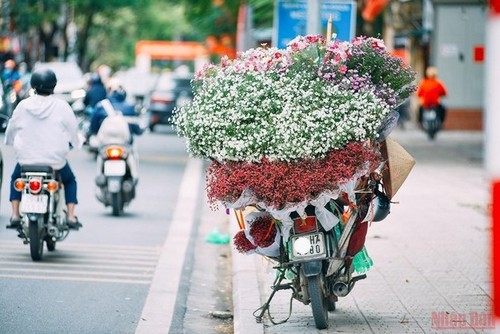 The image of a street vendor’s bicycle dwarfed by a wide range of colorful flowers is popular on Hanoi’s streets these days. The image of a street vendor’s bicycle dwarfed by a wide range of colorful flowers is popular on Hanoi’s streets these days. |
B: Vietnam is now in the days of seasons’ changes, moving from autumn to winter. The weather is becoming cooler with a lot of rain across the country this week. The average temperature in the north is from 20 to 25 Degrees Celsius and 22 to 30 degrees Celsius in the south.
A: Today, we’d like to thank our listeners for congratulating Vietnam in winning the World Records Association’s recognition of its five culinary records.
B: That’s right! The Hong Kong-based World Records Association (WRA) has recently acknowledged five culinary records set by Vietnam.
A: Vietnam has the largest number of 'strand and broth' dishes in the world and the most kinds of Mam (fermented seafood) dishes with unique flavors in the world, WRA stated last month.
B: Vietnam also has the world's most dishes made from flowers; boasts the most kinds of special rolls and the most dishes made from rice flour.
A: These five world records of Vietnam had been recognized by World Records Union (WorldKings), the first union of national and regional records organizations in the world, in late 2020.
B: This is the first time Vietnam has had five culinary records granted by two separate world organizations.
A: We’re so happy to receive the recognition for our culinary records. In VOV programs, we will gradually introduce our culinary specialties to our audiences. That’s you all!.
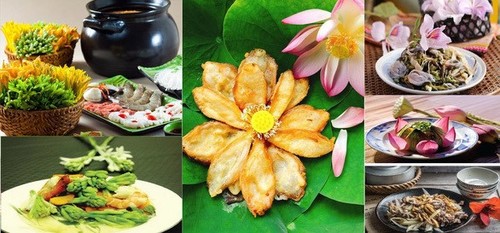 Vietnam has the largest collection of dishes made from flowers. (Photo: vneconomy.vn) Vietnam has the largest collection of dishes made from flowers. (Photo: vneconomy.vn) |
B: Today, let’s explore some of our dishes made from flowers. In Vietnam, fully-bloomed flowers and flower buds can be made into salads, stir fry dishes or used as hotpot vegetables.
A: First, let’s go with banana blossoms. Not all types of banana blossoms are used in cooking. Banana blossoms are harvested when they are young and have a shape like a corn cob.
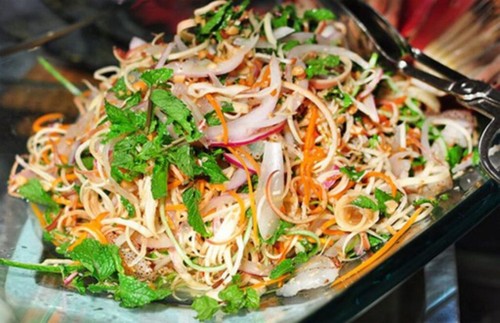 Banana blossom salad (Vietnamese: gỏi bắp chuối or nộm hoa chuối) (Photo: cuisineofvietnam.com) Banana blossom salad (Vietnamese: gỏi bắp chuối or nộm hoa chuối) (Photo: cuisineofvietnam.com) |
B: The blossoms are often thinly sliced into ring-like chiffonades, and used in salads and as a side dish of vegetables in some noodle soup dishes like Hue beef noodle. In one of our Letter Box segments, we introduced a recipe of making banana flower salad to you.
A: Pumpkin flowers are also popular in dishes in Vietnam. Fully-bloomed pumpkin blossoms, and pumpkin flower buds are a common vegetable in family meals and in restaurants. Both fully-bloomed pumpkin blossoms and its bud form are often combined with other ingredients to make stir fry dishes, and sometimes they are crispy-fried as snacks.
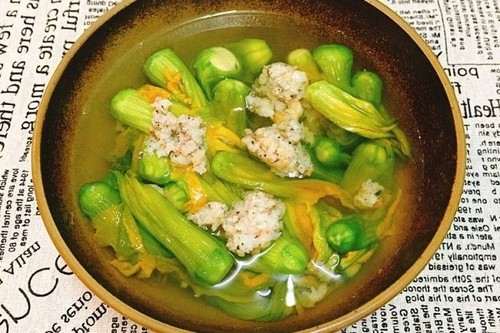 Pumpkin blossoms in a Vietnamese soup Pumpkin blossoms in a Vietnamese soup |
B: Pumpkin blossoms can also be stuffed with chopped or minced meat, can be steamed, and are one of the most highly-prized hotpot vegetables.
A: Sesbania flowers are a genus of flowering plants in the pea family, Fabaceae. In Vietnam, điên điển, or sesbania bispinosa flowers, are popular in the south.
B: These flowers can be used in canh chua, a Vietnamese sour soup dish. Sometimes they are poached together with fish sauce. Sesbania flowers are often harvested in the wild, and are only cultivated in a few places, making them highly desirable.
A: Cowslip creeper or thiên lý flower is a flowering vine plant also known as Tonkin jasmine and Tonkinese creeper. The flower petals can be dried for a tea, while its flower buds are often paired with beef in a stir fry dish
B: Luffa blossoms, or bông mướp in Vietnamese, have similar culinary uses to pumpkin blossoms, but are less common. Luffa vine is cultivated for its fruits used as vegetable. There are “male” and “female” flowers on a luffa vine. So only male flowers are harvested as vegetables.
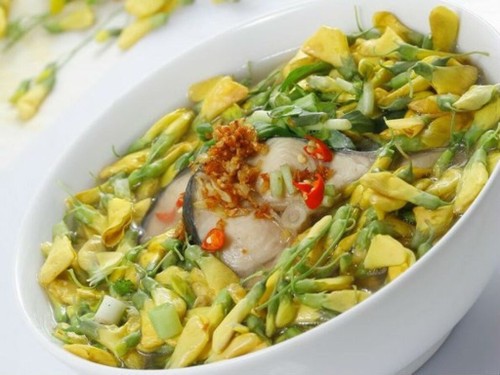 Dien dien sasbania flower sour soup Dien dien sasbania flower sour soup |
A: Bauhinia flowers, or hoa ban, also known as orchid tree or mountain ebony, is a species of flowering plant in the legume family, Fabaceae. In Vietnam, the plants can be found in the northwest region where their flowers are stir-fried with bamboo shoots or stewed with pig trotters. Its edible buds can be tossed in salad dishes, too.
A: In Vietnam, many parts of a lotus plant have culinary uses. Lotus flowers are more likely to be used as a decorative flower, though, as they are so beautiful. Lotus petals are often used to flavor tea leaves to make Vietnamese lotus-flavored tea. In cooking, lotus petals can be used to flavor steamed rice or other ingredients.
B: Well, we have given you a ‘taste’ for just a few fabulous Vietnamese dishes made with flowers. We hope you enjoyed our story and keep tuning into our broadcasts to explore what others flowers can be included in Vietnamese cuisine.
A: Next, we’d like to acknowledge a reception report from Ratan Kuma Paul of India who listened to our broadcast from 16:11 to 16:30 on October 22nd on the frequency of 7220 khz using a telescope antenna and a 50-foot wire.
B: Also listening on the frequency of 7220 khz was Siddartha Battachaje who asked about polio situation in Vietnam.
A: Polio has been eliminated in Vietnam since 2000 but Vietnam continues to give the oral polio vaccine to children under.
B: Prithwiraj Purkayastha wrote: “Greetings from Assam, India. I’ve been tuning in to VOV’s English language service on my Degen 1103 digital receiver a 15-meter wire antenna. It has become a habit for me to tune and check the reception of VOV whenever I get some time to play with my radios. Yesterday I listened your half-hour transmission from 1600 to 1630 UTC and found the signal very strong and clear on 7220 kHz. But, unfortunately, in between transmissions VOV’s signal got fainted and vanished many times resulting in a severe disturbance in listening.”
A: Thank you, Prithwiraj Purkayastha, for your report and attached audio recording of the transmission. We hope to receive more feedback from you.
B: This week, VOVWorld received more than 370 letters and emails from listeners in 38 countries and territories. That’s an encouraging amount of feedback for us not to mention the increasing number of interactions on our Facebook fanpage.
A: In a letter to VOV, Michael Lindner of Germany wrote: “I hope that VOV will never give up its shortwave broadcasts. Besides VOV, it’s hard for me to find information about Vietnam in Germany. VOV’s programs are very interesting and informative about Vietnam.”
A: Lay Darith of Cambodia applauded Vietnam’s vaccination campaign for children which begins this month. He wrote: “After vaccination, children can return to school to rejoin their teachers and classmates.”
B: Javier Gonzalez Nungar of Mexico congratulated Vietnam for being honored as the Top Tourist Destination in Asia in 2021. He wrote: “Though I’m not Vietnamese, I’m proud and happy that Vietnam was honored as the top destination in Asia. Congratulations Vietnam, an enthusiastic and hard-working nation.”
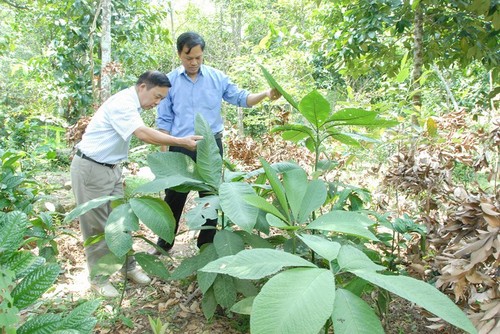 A medicinal herb garden in Tan Dan commune. A medicinal herb garden in Tan Dan commune. |
A: Commenting on our story about the medicinal herbal baths of the Dao ethnic minority, Johnny Antonio Ramírez López of Lima, Peru, wrote: “ I wish the Dao community continued success. Through your unity and hard work, you have found opportunities to strive forward for the common benefit of the community.”
B: Thank you, Mr. López. Therapeutic medicine was developed in Vietnam thousands of years ago, along with experience of using natural resources for survival. Despite the progress of modern medicine, treatment with traditional medicinal plants is often preferred in Vietnam.
A: The Dao in Hoanh Bo district, Quang Ninh province, are famous for their medicinal herb remedies, particularly herbal baths to cure and prevent diseases. From birth, they are intimately connected to the forests attached to the jungles and high mountains. The Dao’s ancestors handed down knowledge of which forest leaves to use in the preparation of medicinal drinks, water to bathe in, and topical balms for pain relief.
B: Dao healer uses between 50 and 200 different herbs to cure common diseases and minor wounds. They often use indigo to treat dermatitis, insect and snake bites, toxicity, and fever. Turmeric is used to treat stomachache and postnatal conditions and aid abortion recovery.
A: A kind of chili helps cure colic or flu. Flax is used in combination with sagebrush to ease tight muscles, treat whooping cough, constipation and skin conditions. According to the Dao, herbal baths improve overall health, blood circulation, and blood quality and protect a person from catching a cold. These remedies have been handed down for centuries.
A: Thank you all for your feedback.
B: We always welcome your comments and suggestions at: English Service, VOVWorld, the Voice of Vietnam, 45 Ba Trieu street, Hanoi, Vietnam. Or you can email us at: englishsection@vov.vn. You can also leave your comments on our website at www.vovworld.vn or on our Facebook fanpage at VOV5 English Service. Thank you all. Stay safe and healthy. Goodbye!